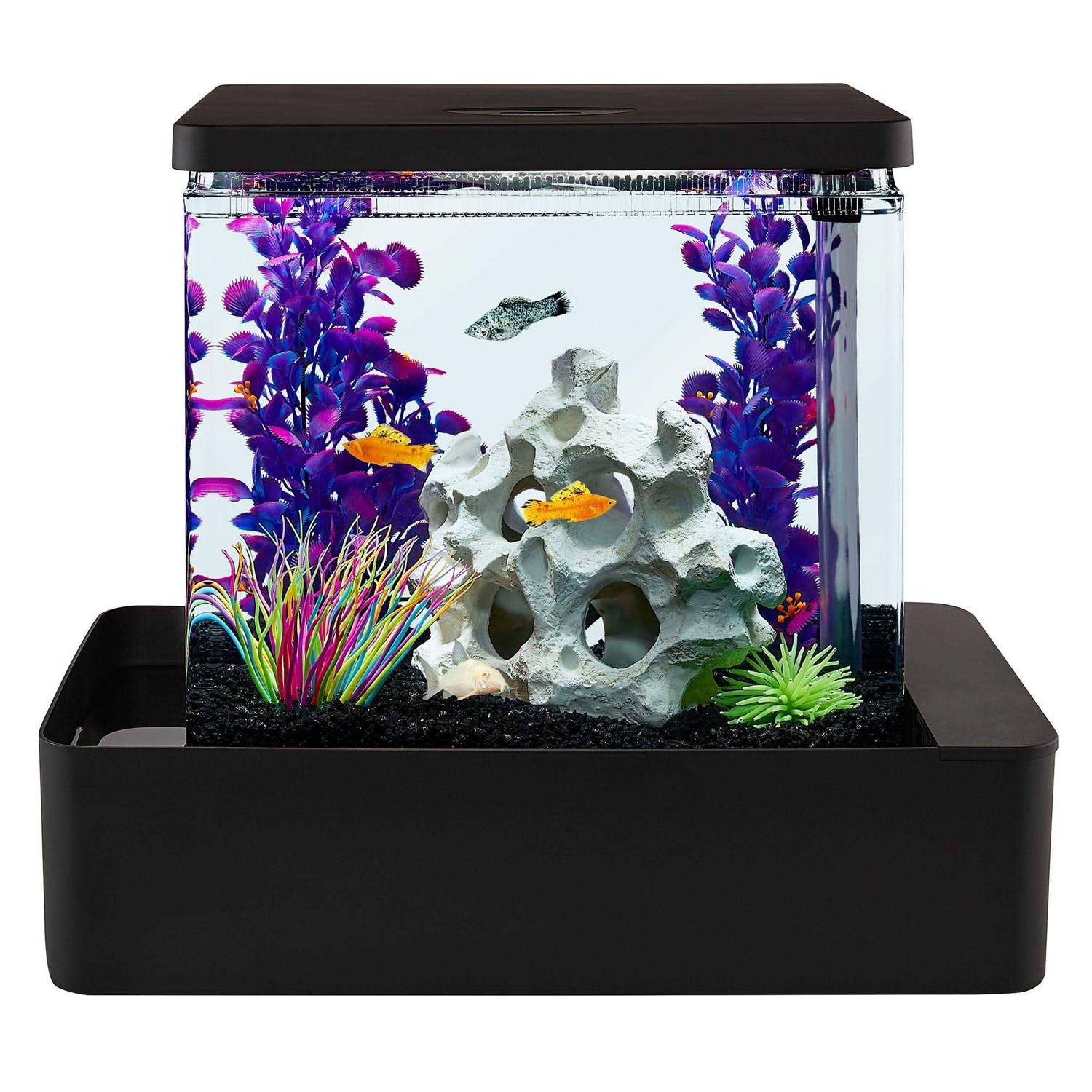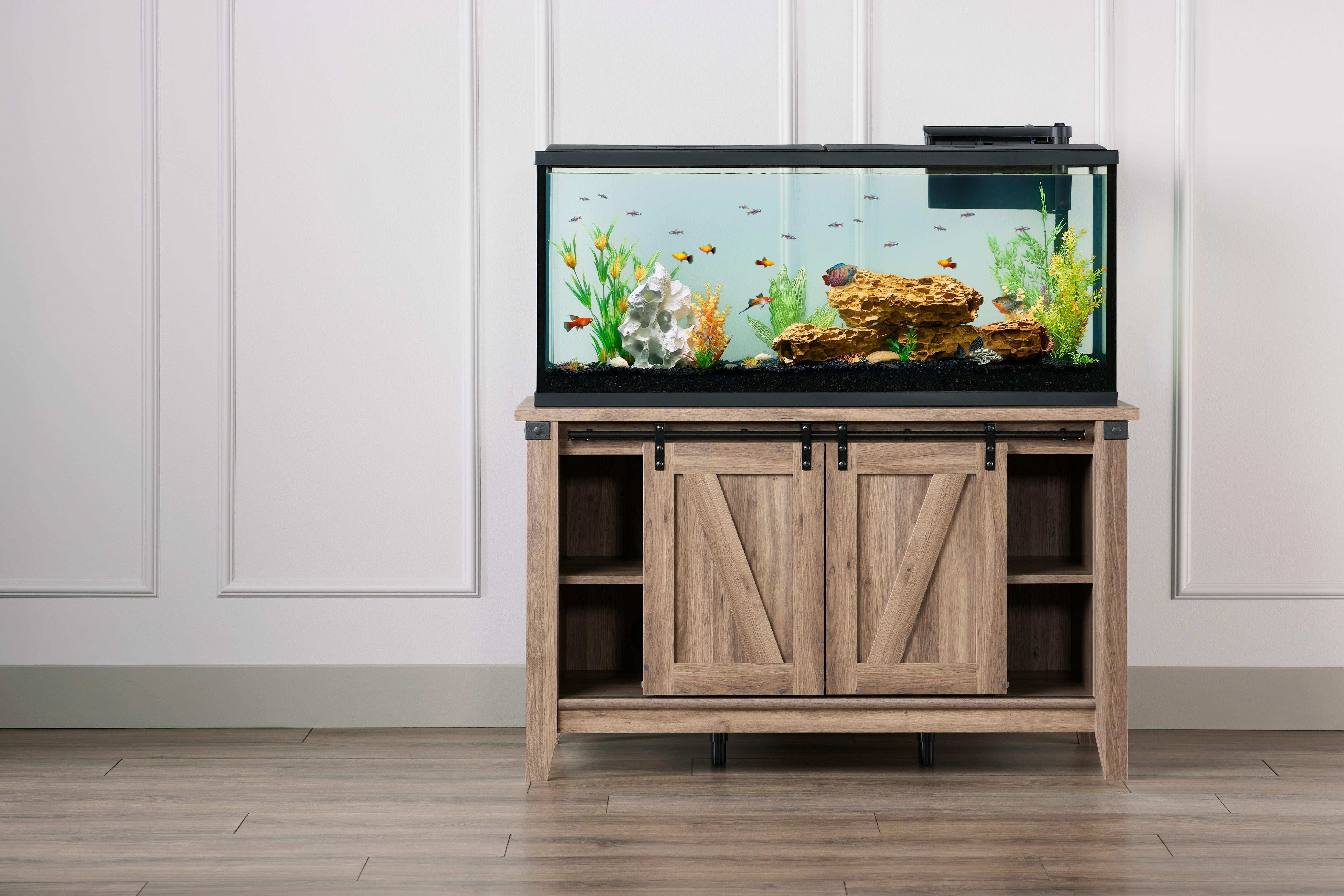Understanding Aquarium Cabinet Assembly: Top Fin Aquarium Cabinet Assembly Instructions

Yo, assembling an aquarium cabinet might seem like a total drag, but trust me, it’s way easier than it looks. It’s all about putting the pieces together in the right order and making sure everything is secure. This guide will walk you through the process step-by-step, so you can chill and assemble your aquarium cabinet like a pro.
Components of an Aquarium Cabinet
Aquarium cabinets are usually made up of a bunch of different parts, each playing a key role in supporting your tank. Here’s a breakdown of the usual suspects:
- Base: The foundation of the whole shebang, the base provides a solid platform for the cabinet and your tank. It’s usually made of sturdy materials like wood or metal.
- Sides: These are the vertical panels that make up the sides of the cabinet, giving it structure and a place to hold the shelves and drawers.
- Top: The top of the cabinet provides a surface for placing decorations or equipment. It’s often made of a durable material that can handle the weight of your tank.
- Shelves: These are used to store aquarium supplies, decorations, or anything else you need to keep handy. They’re usually adjustable to accommodate different needs.
- Drawers: These are great for storing larger items, like filters or extra supplies. They can also add a stylish touch to your aquarium setup.
- Doors: Doors help protect your aquarium supplies and add a touch of style. They’re often made of glass or wood, depending on the cabinet’s design.
- Hardware: This includes all the screws, nuts, bolts, and other fasteners that hold the cabinet together. It’s super important to use the right hardware for each part to ensure a secure assembly.
Assembly Process
Okay, so you’ve got all the pieces, now it’s time to put them together. Here’s the general flow, but make sure to follow the specific instructions that came with your cabinet.
- Read the Instructions: Yeah, I know, it’s not the most exciting part, but it’s crucial. Go through the instructions carefully before you even touch the pieces. You’ll save yourself a lot of headaches down the line.
- Gather Your Tools: Make sure you have all the tools you need, like a screwdriver, a wrench, a hammer, and a level. You’ll also need a tape measure and a pencil to mark measurements.
- Prepare the Workspace: Choose a clean, flat surface to assemble your cabinet. Make sure there’s enough space to spread out the parts and work comfortably.
- Start with the Base: Usually, the base is the first thing you put together. It’s the foundation, so you want to make sure it’s strong and level.
- Attach the Sides: Once the base is secure, attach the sides to it. This will give your cabinet its basic shape.
- Install the Top: After the sides are in place, you can install the top. Make sure it’s level and securely fastened.
- Add Shelves and Drawers: Now it’s time to add the shelves and drawers. Follow the instructions carefully, making sure to align them properly and secure them with the right hardware.
- Attach Doors: Once the shelves and drawers are in place, you can attach the doors. Make sure they open and close smoothly and that they’re securely fastened.
- Double-Check Everything: After you’ve finished assembling the cabinet, double-check that all the parts are securely fastened and that the cabinet is level. It’s better to be safe than sorry, especially when you’re dealing with a heavy aquarium.
Tips for Secure and Stable Assembly
Assembling your aquarium cabinet is all about getting it right the first time, so here are a few tips to help you out:
- Use the Right Tools: Make sure you’re using the right tools for the job. This will make the assembly process smoother and ensure that the parts are securely fastened.
- Follow the Instructions: Always follow the specific instructions that came with your cabinet. They’re designed to guide you through the assembly process and ensure that everything fits together correctly.
- Don’t Overtighten: Overtightening screws and bolts can damage the wood or metal and make it difficult to disassemble the cabinet later on. Use just enough force to secure the parts.
- Double-Check for Level: Make sure the base and the top of the cabinet are level before you start attaching the other parts. This will ensure that your tank sits evenly and that the cabinet is stable.
- Use a Level: A level is your best friend when assembling a cabinet. Use it to make sure that all the parts are level and that the cabinet is sitting straight.
- Don’t Rush: Take your time and assemble the cabinet carefully. Rushing can lead to mistakes that can be difficult to fix later on.
- Get Help: If you’re struggling with the assembly process, don’t be afraid to ask for help. A friend or family member can lend a hand and make the process a lot easier.
Essential Tools and Materials

Yo, so before you start building your awesome aquarium cabinet, you gotta make sure you’ve got the right tools and materials. This will make the whole process a breeze and prevent any major meltdowns.
Let’s break down the essential tools and materials needed to build your aquarium cabinet. It’s all about having the right gear to make the whole process smooth and easy.
Tools
These are the basic tools you’ll need to build your aquarium cabinet. They’re like the MVPs of the build, so make sure you have them on hand.
- Screwdriver: This is a must-have for assembling the cabinet. You’ll need it to tighten and loosen screws.
- Hammer: A hammer is used for driving nails and securing components. It’s like the muscle of the build.
- Tape measure: You’ll need this to measure everything precisely. It’s like the brain of the build, making sure everything fits perfectly.
- Level: A level helps ensure that your cabinet is straight and even. It’s like the perfectionist of the build, making sure everything looks sharp.
- Pencil: You’ll need a pencil for marking measurements and drawing lines. It’s like the artist of the build, outlining the masterpiece.
- Safety Glasses: Protecting your eyes is super important during any DIY project. Safety glasses are like the bodyguard of the build, keeping your eyes safe from flying debris.
- Work gloves: These will protect your hands from splinters and other hazards. They’re like the protectors of the build, keeping your hands safe.
Materials
Now, let’s talk about the materials used in building an aquarium cabinet. There are a bunch of different materials, each with its own pros and cons.
| Material | Pros | Cons |
|---|---|---|
| Wood | Durable, versatile, can be stained or painted, affordable. | Susceptible to moisture damage, can warp or crack. |
| Metal | Strong, durable, resistant to moisture damage, can be powder-coated. | Can be heavy, can rust if not properly treated. |
| Plastic | Lightweight, moisture-resistant, easy to clean. | Not as durable as wood or metal, can scratch easily. |
| Composite | Durable, moisture-resistant, can be molded into different shapes. | Can be more expensive than other materials. |
Troubleshooting Common Assembly Issues
Okay, so you’re putting together your new aquarium cabinet, and things aren’t going as smoothly as you thought. Don’t stress! We’ve all been there, and most of the time, it’s just a small hiccup that’s easy to fix. This section will help you identify and tackle any common assembly problems you might encounter.
Identifying and Solving Common Assembly Problems, Top fin aquarium cabinet assembly instructions
So, you’re looking at the instructions, and you’re like, “Wait, what? This doesn’t make sense!” Or maybe you’ve got a piece that doesn’t fit quite right. No worries, it happens! Here’s a breakdown of some common issues and how to fix them:
- Missing or Damaged Parts: The first thing to check is if you’re missing any parts. Sometimes, they can get lost in the packaging. If you’re missing a part, contact the manufacturer ASAP. They should be able to send you a replacement. If a part is damaged, you might be able to fix it with some glue or tape. But if it’s a major part, it’s best to contact the manufacturer for a replacement.
- Holes Don’t Align: This can be a real pain, but usually, it’s just a matter of slightly adjusting the pieces. If the holes are just a little off, try gently tapping the pieces into place. If the holes are significantly off, you might need to use a drill to make new holes. But be careful! Make sure you’re drilling in the right spot, and don’t drill too deep.
- Screws Won’t Go In: This can be caused by a few things. Make sure you’re using the right screws, and that the screw is going into the correct hole. If the screw is too long, you can try shortening it with a pair of pliers. If the hole is too small, you can try widening it with a drill bit. If the screw is stripped, you’ll need to replace it.
- Pieces Don’t Fit Together: If the pieces aren’t fitting together, it might be because they’re not aligned properly. Make sure you’re following the instructions carefully. If you’re still having trouble, you might need to use a hammer to gently tap the pieces into place. But be careful! Don’t hit too hard, or you could damage the pieces.
Flowchart for Troubleshooting
Here’s a flowchart that can help you navigate through common assembly issues:

Top Fin aquarium cabinet assembly instructions often include detailed steps for attaching doors. This process can be a little tricky, especially when it comes to aligning the hinges properly. If you’re struggling, remember that the principles of hanging cabinet doors hinges apply to most cabinets, including those for aquariums.
By understanding the basics of hinge placement and adjustment, you can ensure your Top Fin cabinet doors open and close smoothly, adding a touch of elegance to your aquatic setup.
Assembling a Top Fin aquarium cabinet is a straightforward process, but sometimes you need a little extra guidance. If you’re familiar with putting together furniture, you’ll likely find the instructions easy to follow. Similar to replacing kitchen cabinet doors before and after , the key is to take your time and double-check your work.
Once you’ve got the cabinet assembled, you can focus on the fun part: setting up your aquarium!

